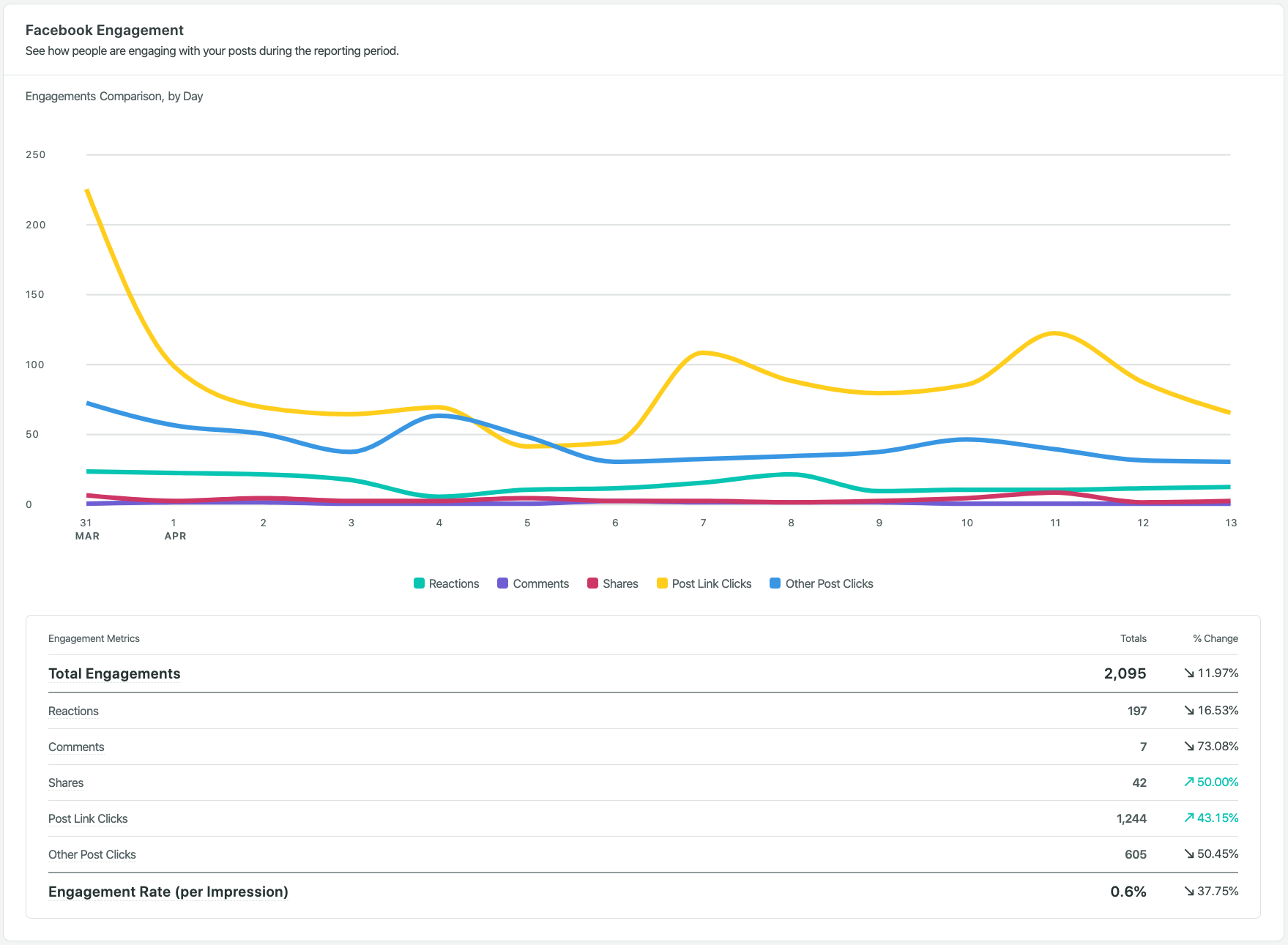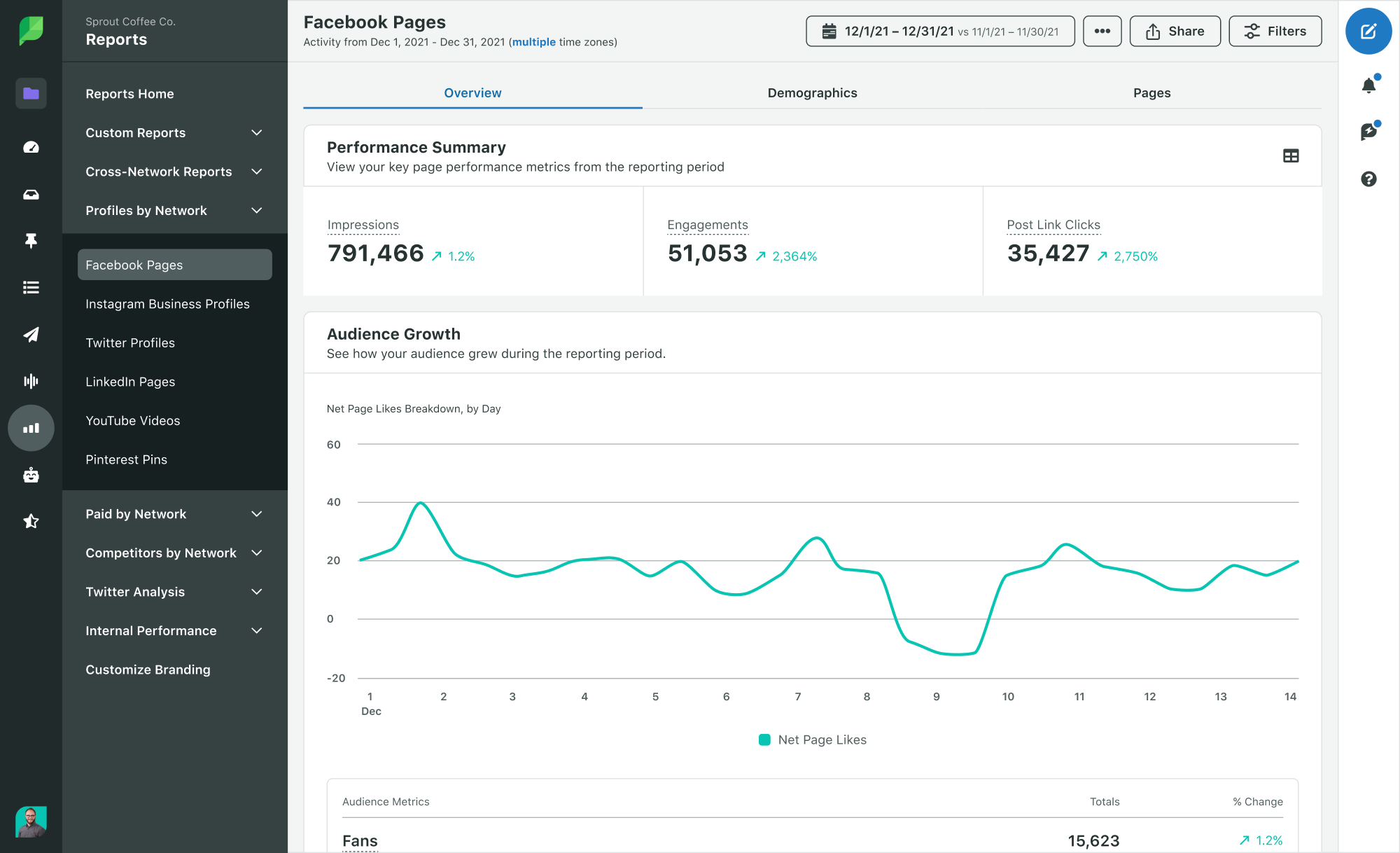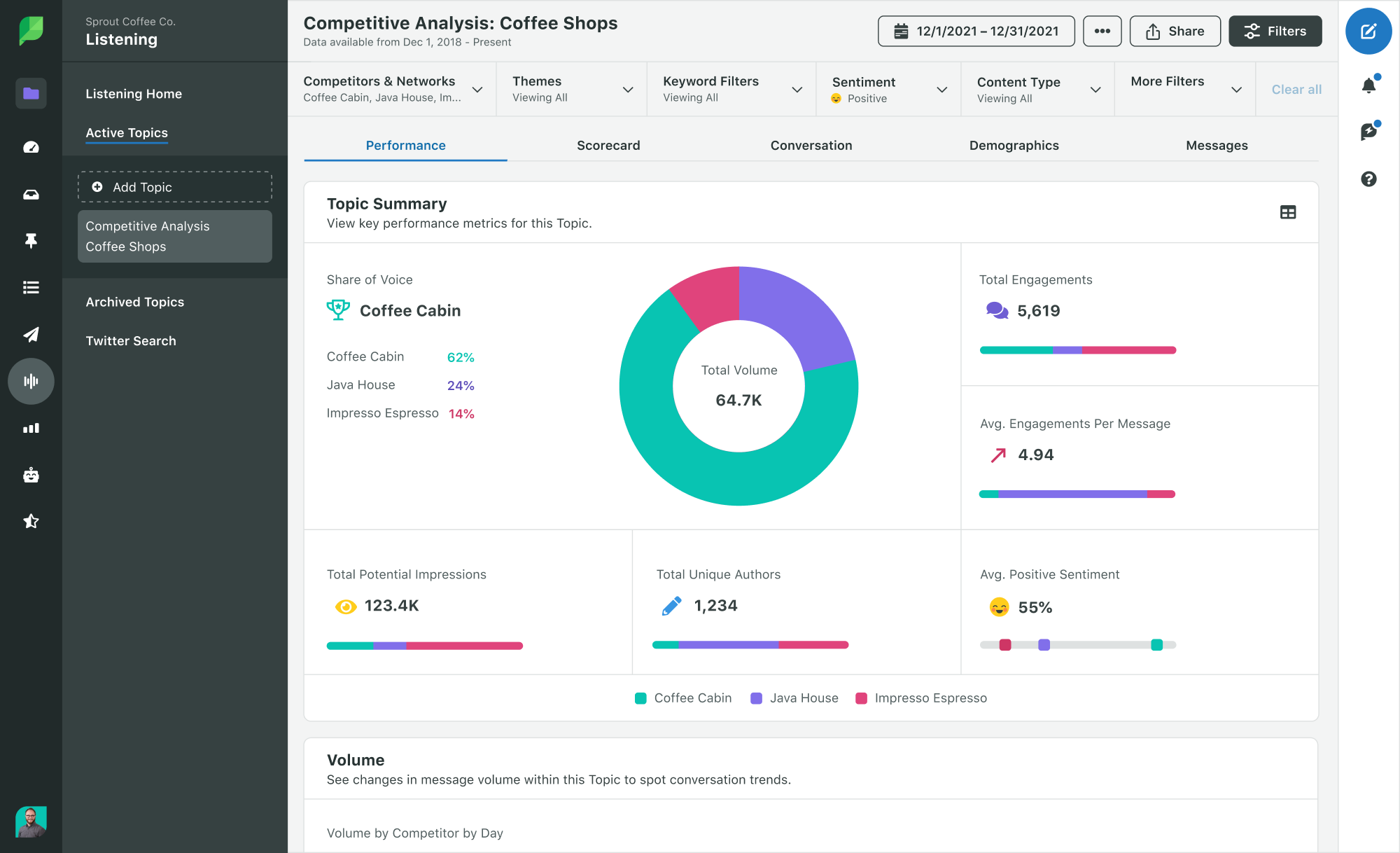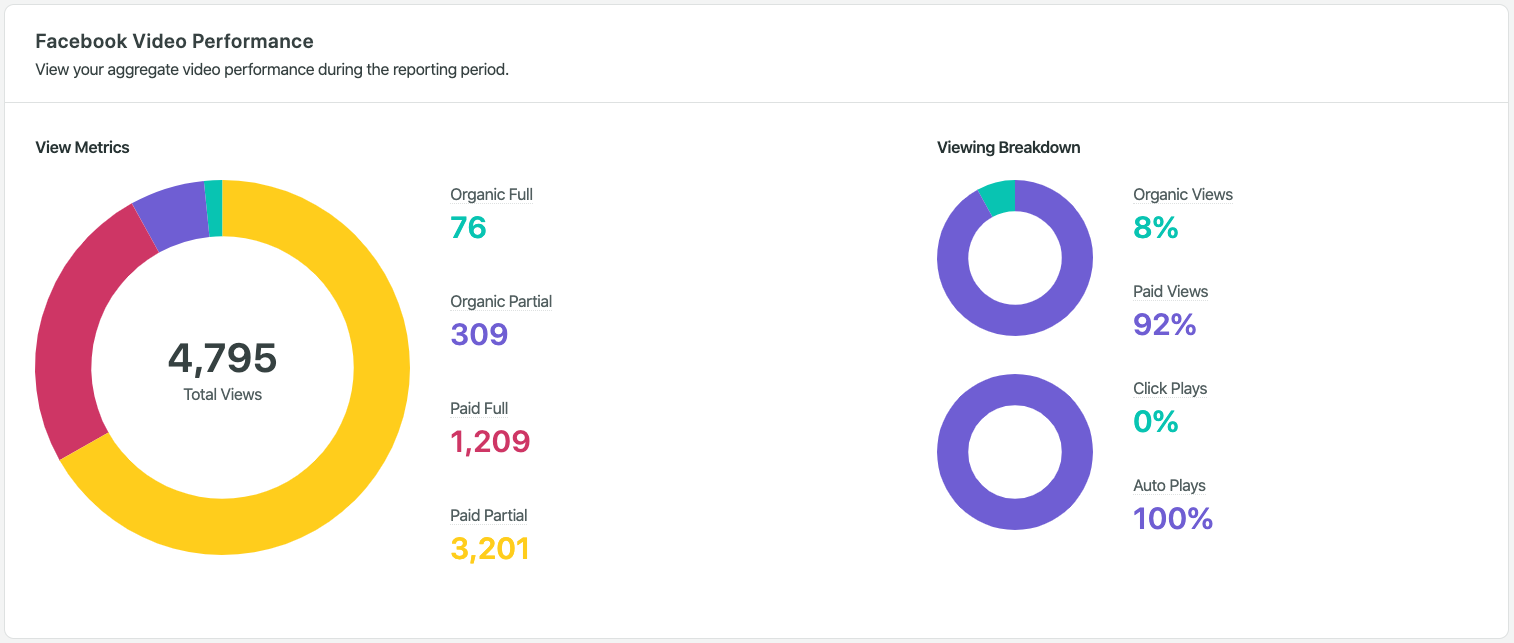16 Facebook metrics every brand needs to track for success

Table of Contents
While Facebook may have matured into ‘my parent’s social media’, it still reigns as the most popular network with over three billion monthly active users. It’s a powerhouse of user data and specific targeting for marketers. Maximizing its full potential lies in tracking the right metrics that provide actionable insights for driving strategy and growth.
Meta sometimes removes or changes Facebook metrics as the platform and user habits evolve. Gone are the days when only followers and likes mattered; now, you need to think about engagement, views and conversions, which come in various forms.
Imagine having a crystal-clear view of what’s working and what’s not, so you can fine-tune your Facebook marketing strategy for maximum ROI. In this article, we’ll dive into the essential Facebook metrics you should be tracking. From engagement rates to click-through rates, we’ll help you cut through the noise and focus on the data that truly matters.
Why you should analyze your Facebook metrics
People use social media for a variety of reasons, and that’s no different for Facebook. According to Pew Research, 93% use Facebook to keep up with friends and family, but they’re also using it to look at product reviews or recommendations (37%), get news (37%) or to keep up with sports or pop culture (36%).
How the public uses Facebook versus how your target audience uses it won’t always be the same. When followers engage on your posts, is it because you posted at the best time or other metrics? Monitoring and analyzing the most important Facebook metrics helps you understand your audience, and then you can tailor your content and optimize your strategy accordingly. Focusing on the most important Facebook metrics can also reveal if a campaign is successful, if your Facebook Lives are drawing high engagement, how well that brand Group is performing and more.
What to consider before tracking Facebook metrics
Before you dive into Facebook analytics, you need to navigate the art of intentional tracking. It’s tempting to cast a wide net and track everything. But not all data is created equal. Take a step back and ask yourself: Why am I tracking this?
Your metrics should support specific marketing objectives, as this will help you define the ROI of your efforts. Understanding key Facebook KPIs is crucial in this process. Whether you’re increasing brand awareness or fostering customer loyalty, the metrics you track should reflect how your efforts are impacting the bottom line. If your goal is audience targeting, focus on demographic insights and engagement rates. If brand awareness is your aim, prioritize reach and impressions. Tracking everything without a clear purpose can lead to data overload and dilute your Facebook strategy (and your successes).
Identifying the most important Facebook metrics for your brand gives you a compass that guides your marketing strategy. By being intentional, you can avoid analysis paralysis and instead enable yourself to quickly gain actionable insights that drive meaningful results.
16 Facebook metrics you should track
Below are 16 Facebook metrics you should track, grouped together by category.
- Facebook Page & Post metrics
- Facebook brand awareness metrics
- Facebook Group metrics
- Facebook video metrics
- Facebook ad metrics
Facebook metrics can be found in several ways. For the native route, Facebook offers Insights, found in Meta Business Suite, which provides filterable metrics across multiple Pages. Sprout Social also offers reports that you can easily review alongside your other network profiles.
Don’t have a Sprout Social account? No problem! Start your free 30-day trial — all you need is your business email. Once you connect your Facebook account, you can dive into your personalized data and pinpoint the metrics that matter most to your business goals.
Facebook Page & Post metrics
This section covers the social media metrics that are most commonly associated with how your posts or Page perform.
1. Engagement
Engagement is the catchall term for interactions a user has with a Page’s post and profile. Facebook engagement metrics can include but aren’t limited to reactions, link clicks, shares, comments, clicks to the profile and more.
Why you should track Facebook engagement metrics:
- Tells you how your post resonates with your audience.
- The more a post is interacted with, the more likely it is to show up in your fans’ Newsfeed.
- Looking at overall engagement and the breakdowns per type of engagement tells you how people are reacting to your posts.
Where to find it: Within Meta Business Suite, go to Insights > Content > Overview.
In Sprout, engagement analytics are part of the Facebook Pages Report. Facebook engagement metrics broken down for you to easily review. You can also access the Post Performance Report, which details all the engagements that happened with every post.

2. Engagement rate
Engagement rate is the total number of engagements divided by the total reach number. Multiply that number by 100% to get the engagement rate of your post.
Engagement rate = (total engagements / total reach) x 100%
Why you should track engagement rate: Your engagement rate, whether high or low, can tell you a lot about your posts. An engagement rate per impression shows you how interesting your post was compared to the number of times it was shown. For example, a high engagement number with a very high impression number tells a different story from a high engagement number with a low impression number.
Where to find it: In Meta Business Suite, you can find detailed engagement metrics within Insights. In Sprout, the engagement rate per impression for organic and paid posts is automatically calculated in the Facebook Page Report. Monitoring your engagement rate will help you detect trends in audience behavior toward your content. If your engagement rate is trending high, then you’re hitting the right notes with your audience. But, if it starts dipping, then you can proactively start planning how to increase your Facebook post engagement.
3. Reach
Facebook makes a distinction between reach and impressions. At the post level, reach is the potential unique viewers a post could have. This includes both organic and paid reach.
Why you should track reach: Reach gives you a clear picture of how many unique people saw your post or Page. For example, you could have 10 impressions but only one reach on a post. In conjunction with other metrics like impressions, reach tells you if your posts or Page are finding people who are interested in your brand.
Where to find it: In Meta Business Suite. reach is also found within Insights. In Sprout’s Post Performance Report, you’ll find average reach and average potential reach per post as part of Premium Analytics.
If you’re looking to boost this metric, we’ve outlined six different tactics to help you increase your Facebook reach.
4. Impressions
Either equal to or higher than the reach number, impressions are how many times a post shows up in someone’s timeline.
Why you should track impressions:
- The more times someone sees your post, the more interesting it might be to them.
- Repeat impressions mean that someone either saw it multiple times in their feed or, even better, navigated back to find the post or your Page again.
Where to find it: In Meta Business Suite, per-post impression metrics are found in the Insights section within Content.
In Sprout, Page impressions are at the top of the Facebook Page Report. You can find post-level impression metrics in the Post Performance Report.

5. Page likes & followers
As one of the very first metrics for Facebook Pages, likes and followers indicate how willing someone is to stay in touch with your brand. They might like a post or two, but if they hit the Like or Follow button, then they likely want to see more of your content and know more about your brand.
Why you should track Page likes and followers:
- This metric tells you how interested someone is in your company, but shouldn’t be standalone metrics.
- Compare your impressions with your likes to understand how far your posts are really going.
Where to find it: In Meta Business Suite’s Insights, likes are in the Overview and Audience sections. In Sprout, you can find these metrics in the Pages tab of the Facebook Pages Report.
Facebook brand awareness metrics
This section covers how people find your brand, what demographic groups they’re part of and your share of voice on Facebook.
6. Facebook referral traffic
This metric describes the number of times someone visited your website from your Facebook Page. If you publish a lot of blog posts or product links on Facebook, this is a good metric to monitor.
Why you should track Facebook referral traffic: Significant referral traffic indicates your Facebook posts are effective. This number is excellent for general traffic tracking but also for ad campaigns where you create a landing page on your website.
Where to find it In Sprout, connect your Google Analytics and find the metrics in the Google Analytics Report. Alternatively, you can head to Google Analytics itself to find it in the Acquisition section within Reports.

7. Follower demographics
Demographics metrics break down your audience base so you can tailor your content better to their interests and lifestyle. Where do they live? What age are they?
Why you should track Facebook follower demographics: Knowing who makes up your audience helps you tailor your content better. Your audience demographic is an important component of building your brand’s social media personas.
Where to find it: In Insights within Meta Business Suite, the Audience tab provides demographics details. In Sprout, the Facebook Page Report has a Demographics tab that breaks your audience down by country and city.
8. Share of voice
Share of voice is usually part of a competitive analysis or paid advertising campaign. It indicates how much your brand is appearing and being discussed within Facebook’s global network.
Why you should track Facebook share of voice:
- Understand how your brand’s presence compares to competitors in your industry.
- Measure the visibility and reach of your brand’s message and content.
- Identify trends and shifts in customer interests and behaviors as it relates to your brand.
- Evaluate the impact and success of your marketing campaigns.
Where to find it: Sprout’s Social Listening solution helps you track and automatically calculate your share of voice. Input the keywords and topics you want to track and then periodically check in on the results. Listening Topic Insights are filterable to a per-network level, so you can understand how your share of voice compares between Facebook and other networks like X (formerly Twitter).

Share of voice isn’t automatically calculated within Meta Business Suite, so you’ll need to use this formula to manually calculate it:
Share of voice = your brand metrics / total market metrics
This can be time consuming, so that’s why this metric is typically best tracked within a social media management platform.
Facebook Group analytics
This section focuses on analytics that are specific to Facebook Groups.
Where to find it: You’ll be able to find the metrics if you are logged into the Group as an admin. Group Insights are available for Groups that are larger than 50 members. Meta deprecated Facebook Group functionality in their API, so publishing, engaging and tracking are only available within Meta’s Group Insights.
9. Top contributors
Top contributors tell you who’s most engaged inside your Group. These individuals are likely your biggest brand advocates who enjoy your content.
Why you should track Facebook Group top contributors: Use this metric to identify your brand advocates. Track this metric to help you find opportunities to surprise and delight your audience, and keep track of people who may be able to help moderate discussions.
10. Engagement
This metric gives you the days and times your members are most active, as well as posts, comments and reactions counts.
Why you should track Facebook Group engagement: Determine the best time to post on Facebook and how your members are engaging with posts.
11. Growth
Growth in Facebook Groups shows how many new members and active members you have within a period of time.
Why you should track Facebook Group growth: You want to grow your brand community and monitor how quickly it’s growing. Building an engaged Group will indicate how well you’re engaging your audience. Not as much growth as you want? You’ll need to focus on additional ways to promote your Group.
Facebook video analytics
There are several Facebook video metrics to track. The main video view metric used by Meta is three-second video views. This means that video views are counted after a video is watched for three seconds. Video metrics are found at a per-video level within Meta Business Suite under Insights > Video. For individual videos, go to the Content section.

Sprout’s Facebook Page Report also provides metrics on video performance that are broken down into organic and paid results. Additionally, find post-level video metrics in our Post Performance Report.

12. Audience retention
Audience retention is how long someone watched over the duration of the video.
Why you should track Facebook video audience retention: Gauge how interesting your videos are to your audience to guide your video marketing strategy. If your videos are five minutes long and most users are watching only five seconds, then you may need to experiment with shorter video lengths.
13. Video engagement
Similar to post engagement, the video engagement metric is specific to the Facebook videos you post. For videos, engagements are broken down into reactions, shares and comments.
Why you should track Facebook video engagement: Reactions to your videos tell you what your viewers are feeling when watching and if they match your expectations.
Facebook ad metrics
Specific to Facebook ad campaigns, these are the most important metrics to watch to make sure your ads are running efficiently. There are many ways to run a campaign, so it’s best to choose metrics that align with your campaign goals. For example, click-through rates (CTR) might be important for ads trying to convert prospects into customers, while cost per impression (CPM) may be more important for brand awareness goals.
Sprout’s Paid Performance Report features analytics from your Facebook campaigns. Having this data on hand makes it easy for you to evaluate and adjust Facebook advertising strategy based on the metrics most important to your goals.

Your Facebook campaigns can also be evaluated within Facebook Ads Manager, which features graphs and specific metric breakdowns, including engagement, people reached and spend.

14. CTR
Click-through rate (CTR) is the number clicks on your ad divided by the number of times it’s been shown. This is best examined when you want someone to take action on the ad. In some cases, such as those that are aiming for a high impressions count, CTR doesn’t matter as much as CPM would.
15. CPC & CPM
Cost per click (CPC) refers to the amount you pay for every click on your ad. Cost Per Mille (CPM) is the cost per 1000 impressions. This is most often measured for brand awareness campaigns.
16. CPA
For campaigns with specific actions, like an app install, cost per action (CPA) is measured per action, meaning the user will need to click the ad’s CTA to perform the action.
How to transform your Facebook marketing strategy with Facebook metrics
Facebook metrics aren’t just numbers on a screen, but a blueprint for transforming your brand’s social strategy. By understanding and leveraging these insights, ideally with a comprehensive Facebook analytics tool, you can make data-driven decisions that keep your brand relevant and successful on Facebook.
But how do you turn those numbers into actionable optimizations, or new approaches that up-level your strategy? Here are a few tips to help you put that data into action.
Know your crowd
Facebook is a wealth of audience insights, from where they are located to which posts they’re engaging with most and how they’re talking about your brand or industry. These details help you tailor your content and ads to the right people.
You can use Sprout to inform every aspect of how you engage with your audience. Through our Social Listening, discover your audience’s interests and how they’re talking about your brand to inform the topics you post about or improve your social customer care. Even catch crises early on, so you can manage the situation from the start.
Refine your content strategy
Then, you can take it a layer deeper. Our platform offers a bird’s-eye view of what’s working and what’s not, and enables you to dig into post-specific details. Engagement rates, likes, shares and comments tell you what types of content your audience loves. Is it videos, images or text updates? By identifying your top-performing posts, you can refine your content strategy to give your audience more of what they crave.
For example, if you notice that behind-the-scenes videos garner the most engagement, then prioritize creating more of that content. This not only boosts interaction but also fosters a deeper connection with your audience because you’re personalizing the experience to their needs.
Optimize your ad spend
In an age when marketing budgets are being slashed, you want to make the most of the ad spend you do get. Tracking ad metrics like click-through rate (CTR), cost per click (CPC) and cost per acquisition (CPA) helps you quickly evaluate the effectiveness of your Facebook ad campaigns.
For example, if you notice a high CTR but prospects are converting at a low rate on your landing page, it might indicate that your ad is compelling but your landing page needs improvement. Conversely, a low CTR could mean your ad creative or targeting needs tweaking.
Sprout’s Paid Performance Report helps take the guesswork out of ad optimizations, giving you access to the metrics you need to make the right decisions quickly. And further enabling you to make timely adjustments that optimize your ad spend and maximize Facebook ROI.
Turn Facebook metrics into insights
Facebook metrics aren’t just about collecting data. It’s about discovering insights that transform your presence and drive your marketing strategy forward. By being intentional about what you track and understanding the ‘why’ behind each metric, you can continue to push for excellence and align your efforts with what’s important to the overall business.
From finding out what resonates with your audience to optimizing your ad spend, Facebook metrics help you take the guesswork out of social strategy. As you refine your strategy based on these insights, you’ll build more meaningful connections with your audience, and prove the ROI of your strategy.
Try Sprout free for 30 days to see how we can help you accelerate your entire social strategy.



Share